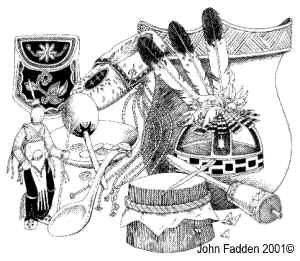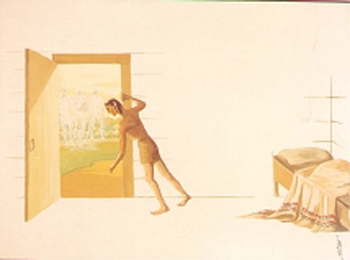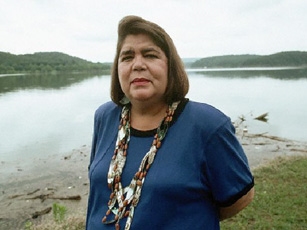 |
| "Handsome Lake Preaching His Code at the Longhouse" by Ernest Smith - Image courtesy of the Rochester Museum & Science Center |
Handsome Lake (1735?-10 Aug. 1815), Seneca prophet, was born probably in what is now western New York State. He was the half brother of Cornplanter and the nephew of Guyasuta. Although he served as a warrior against the Cherokees in the 1760s and aided the British during the Revolution, he does not seem to have particularly distinguished himself. Apparently during the 1790s he received the title Handsome Lake (Ganeodiyo, the name traditionally borne by one of the sachems chosen to represent the Seneca at the national Iroquois council), and in that capacity he signed the treaty of Big Tree (1797), by which the Iroquois of New York were left with eleven reservations. The name used by Handsome Lake before acquiring his title is not known. In 1799 he was living an intemperate life in Cornplanter's town on the Allegheny River in one of the Iroquois reservations.
Handsome Lake's reforms were rooted in the wretched conditions of the Iroquois communities. Their populations had been reduced by war and disease, and their economies were faltering. As white settlement around the reservations grew, the hunting declined and the Indians became overdependent on the horticulture performed by the women and on inadequate treaty annuities. Morale was also low. The retreat of the hunting and warrior life, and with it traditional paths by which many men achieved fulfillment or prestige, created indolence and alienation. Alcoholism, violence, depression, and accusations of witchcraft were common problems.
 |
| courtesy of Iroquois.net |
These difficulties provoked several somewhat contradictory responses. From 1798 onward, Quakers were at work in Cornplanter's town, not so much to proselytize as to develop the Indian economy, to intensify agriculture, and to teach stock raising, spinning, weaving, and the fencing of land. They also attacked social problems such as drunkenness. But while this program, involving the reformation of the local economy, was under way, a simultaneous nativist movement began. A Mohawk claimed that the Creator (Tarachiawagon) was displeased with the Iroquois for neglecting such ceremonies as the worship dance. This prophet was mainly influential among the Oneidas of New York and the Canadian Iroquois, but in February 1799 a Seneca in Cornplanter's town declared that he had visited hell and witnessed the torments of drunkards and other sinners. Thus, native prophets ascribed the misfortunes of the Iroquois to the anger of the Creator at the decline of traditional observances and the assimilation of undesirable white influences. Handsome Lake distilled both the Quaker and the nativist impulses for his own reforms.
Between June 1799 and February 1800 Handsome Lake experienced three visions, recorded in the contemporary Quaker diaries. According to Henry Simmons, on 15 June, Cornplanter was told that his brother was dying and found him "laying breathless for the space of half an hour, but in about two hours after he came to himself again," and related that angels had visited and instructed him. The following August the prophet "fainted or fell into a trance in which posture he remained 7 hours; his legs and arms were cold; his body warm but breathless." When he recovered, Handsome Lake claimed to have visited heaven, and after a third vision he reported a further visit of the angels. From these incidents Handsome Lake professed himself the medium of the Creator and the bringer of the Gaiwiio or Good Word.
 |
| "Handsome Lake and the Three Messengers" |
The message was apocalyptic, declaring that unless the Indians reformed, they would suffer sickness, drought, and flood, while the sinful would be excluded from heaven. The proscribed sins were largely those already condemned by nativist preachers and the Quakers--drunkenness; the practice of witchcraft, which the Indians blamed for disease and strife; violence; the neglect of old ceremonies; and even the riotous "frolics and dancing" condemned by the Quakers. Subsequently Handsome Lake broadened his message to sanction the economic development promoted by the Quakers, but he insisted that farming should be for subsistence and that surpluses be made available to the native community rather than for commercial sale.
Not unnaturally, the Quakers and President Thomas Jefferson, whom Handsome Lake, as a member of an Iroquois land and agriculture delegation, visited in 1802, endorsed Handsome Lake's campaign, which was neither anti-American nor excessively nativist. Yet his was not a servile doctrine. Handsome Lake recognized the need to raise the material standards of the Iroquois and to adjust to the existence of a dominant white society, and he backed economic development and peace with the United States. But he offered the Indians a religion distinct from Christianity, one that preserved native ritual and the aboriginal emphasis upon community life. Such Christian influences as it embraced were integrated into traditional Indian beliefs. For example, the notion of God and the Devil directing the forces of good and evil and competing for souls was blended into the Iroquois creation story of the good and bad twins. Handsome Lake also opposed the further sale of land to the United States. His religion facilitated Iroquois adjustment to reservation life but protected their culture and identity. It was partly for this reason that Handsome Lake's religion, while more localized than that of his contemporary Tenskwatawa, the Shawnee prophet, enjoyed greater longevity. Handsome Lake's preaching was compatible with living alongside the European-American farming frontier; Tenskwatawa's, espousing a return to more traditional Indian ways of life, was rooted in an ultimately disappearing Indian world.
Handsome Lake's influence was strongest among the Senecas, Onondagas, and Oneidas of New York, although it spread to the Wyandots and Iroquois of the Sandusky in Ohio, whom he visited in 1806. By then Handsome Lake, the Quakers, and others had done much to reduce Iroquois drunkenness and spur economic development. Some Iroquois men were beginning to reappraise their traditional contempt for husbandry. In 1801 the prophet was briefly elevated to the unprecedented position of premier sachem of the New York Iroquois. However, he abused his power with overzealous accusations of witchcraft, and consequent executions threatened to create blood-feud conflicts. In 1801 the Senecas and Delawares of Cattaraugus were brought to the brink of hostilities on account of Handsome Lake's activities, and he divided the Senecas, denouncing his political enemy, Red Jacket, for witchcraft. After the execution of a woman in 1809, Cornplanter admitted, "I hope we shall be careful in future how we take the lives of any for witchcraft, without being sure that they were guilty." In 1803 Handsome Lake's relations with his brother had so deteriorated that the prophet had left Cornplanter's town and established a new settlement at nearby Cold Spring.
Handsome Lake died on a visit to Onondaga, but his teaching survived, reworked and codified by individual preachers, and remains a significant force in Iroquois life, offering a distinctly Indian alternative to Christianity.
Page created on 11/19/2006 3:35:19 PM
Last edited 11/19/2006 3:35:19 PM
